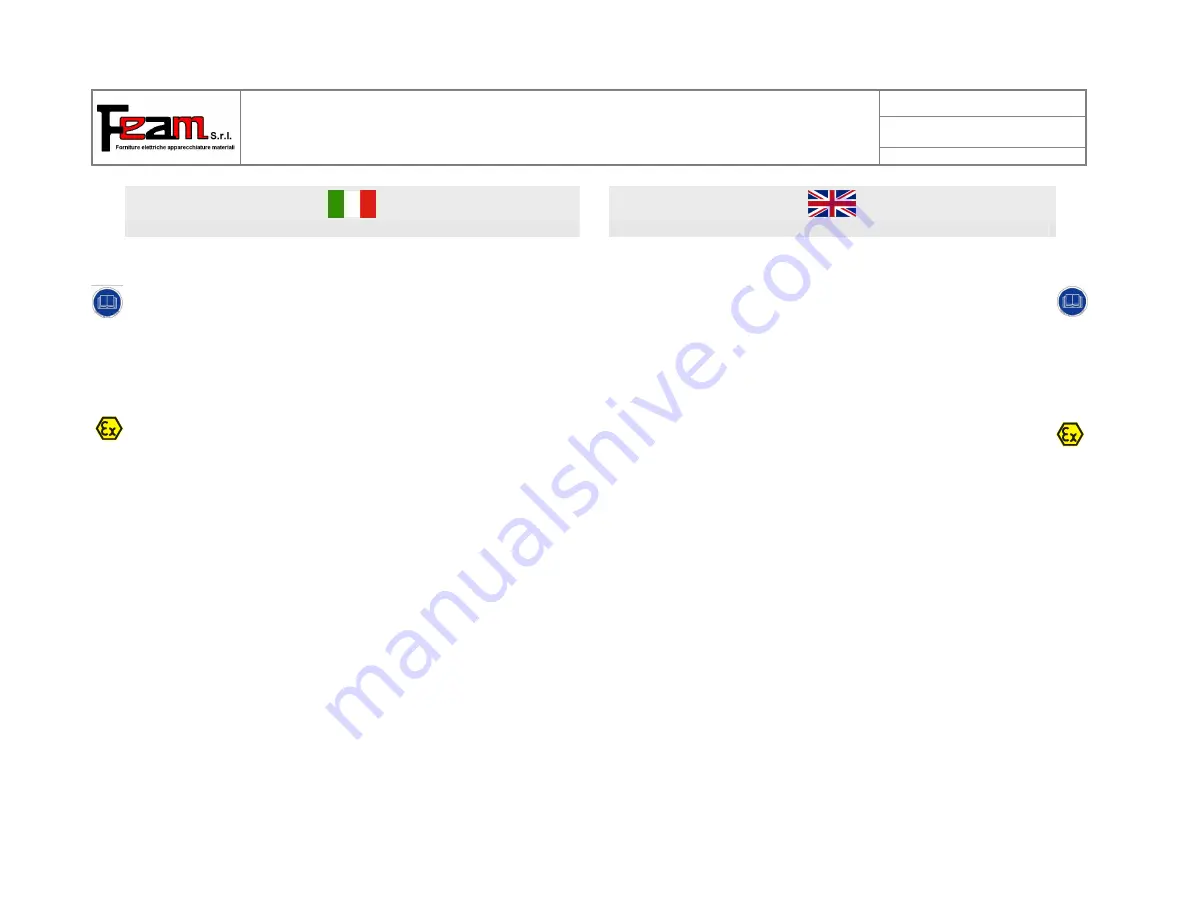
I
I
s
s
t
t
r
r
u
u
z
z
i
i
o
o
n
n
i
i
p
p
e
e
r
r
l
l
’
’
u
u
s
s
o
o
I
I
n
n
s
s
t
t
r
r
u
u
c
c
t
t
i
i
o
o
n
n
f
f
o
o
r
r
u
u
s
s
e
e
0
0
2
2
/
/
1
1
1
1
-
-
E
E
X
X
-
-
I
I
U
U
revisione 0 del 2011.03.11
pagina 9 di 14
Il presente documento è di proprietà della F.E.A.M. S.r.l. La sua riproduzione in qualsiasi formato, integrale o parziale, deve essere preventivamente autorizzata dalla F.E.A.M. S.r.l.
The present document is property of F.E.A.M. S.r.l. Its copyright in any format, whole or partial, must be before authorized by F.E.A.M. S.r.l.
02-11-EX-IU_Rev.0 - per organismo ita-eng.doc
3.3
Note importanti
3.3
Important notes
Eventuali parti danneggiate dovranno essere sostituite o ripristinate
esclusivamente a cura del produttore, salvo particolari autorizzazioni da parte
dello stesso.
Il piano di accoppiamento tra corpo e coperchio non deve presentare solchi o
graffiature che precludano la planarità dell'accoppiamento (max interstizio 0,05
mm) e la rugosità delle due superfici (
≤
6
µ
m). In caso di danneggiamento delle
superfici oltre i valori anzidetti, contattare il produttore.
Tutte le viti del coperchio devono sempre essere avvitate completamente; in caso
di sostituzione usare sempre viti dello stesso tipo e grado di resistenza (ISO 4762
- qualità 8.8).
Ad ogni apertura del coperchio bisogna ripristinare il grasso al silicone
(LOCTITE_8104 o LOXEAL_GS9) sui giunti di laminazione per garantire il grado
di protezione IP 65.
Il morsetto di terra interno ed esterno è previsto per il collegamento del conduttore
che deve essere disposto tra la rondella antirotazione e quella piana. Se il
collegamento viene effettuato tramite capocorda, questo deve essere provvisto di
dentino antirotazione, oppure si deve provvedere un qualsiasi mezzo che assicuri i
conduttori contro la rotazione.
I fori della custodia non utilizzati, dovranno essere chiusi da tappi conici o cilindrici
in maniera tale da mantenere le caratteristiche di tenuta all'esplosione della
custodia. Gli stessi dovranno poter essere smontati solo con utensili speciali.
Le entrate di cavo devono avere una marcatura che identifica, la grandezza ed il
tipo di filettatura del foro, questi dati devono essere identificati tramite una
targhetta adesiva posta in prossimità dell’imbocco.
Any damaged parts may only be replaced or repaired by the manufacturer,
unless of express authorization of itself.
The matching surfaces of body and cover must not be furrowed or scratched so
as to impair their flush meeting (max. gap 0.05 mm) or the roughness of the two
surfaces (
≤
6
µ
m ). If the surfaces are damaged so as not to meet the above
specification, please to contact the manufacturer.
All cover screws must always be tightened completely and may be replaced only
with screws of the same type and the same degree of resistance (ISO 4762 -
quality 8.8).
At every opening of the cover is necessary to restore silicone grease
(LOCTITE_8104 or LOXEAL_GS9) on lamination joints to guarantee degree of
protection IP65.
The ground terminal board in and out is preview for the conductor which must
placed between the anti-rotation washer and the flat washer. If the connection is
made by means of lug, this must be with an anti-rotation pin, or must be provide
on fitting to avoid the rotation of the cable.
Any unused holes in the enclosure must be closed with conical or cylindrical
plugs in such way that anti-explosion seal characteristics of the enclosure are
preserved. These plugs must only be removed with special tools.
The cable entries must have a marking, that identifies the size and type of
threading, such data must be identified with a adhesive label placed in proximity
of each cable entry hole.
































